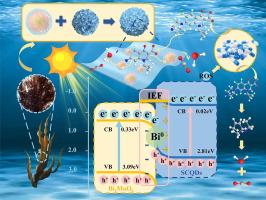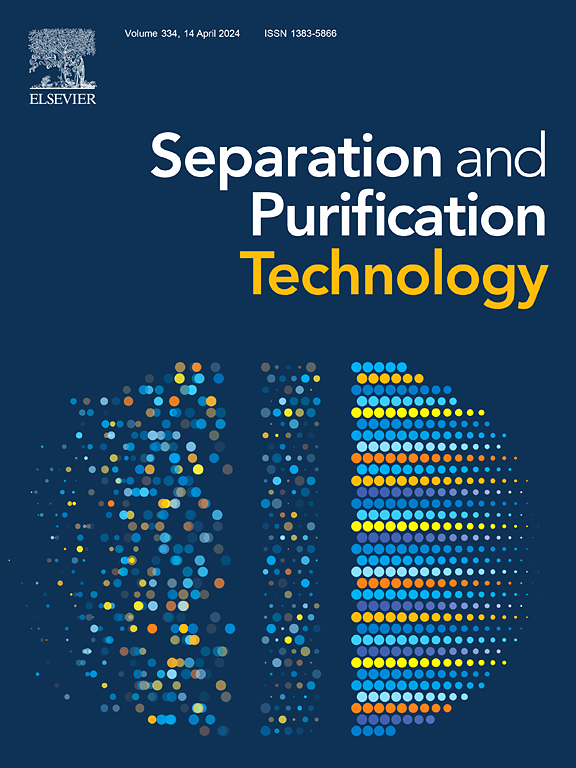Algal carbon quantum dots/Bi2MoO6 S-scheme heterojunction with enhanced visible-light photocatalytic degradation for ciprofloxacin
IF 8.1
1区 工程技术
Q1 ENGINEERING, CHEMICAL
引用次数: 0
Abstract
The formation of S-scheme heterojunctions offers a viable strategy for enhancing photocatalytic efficiency in tackling organic contaminants. However, the green, low-cost, easy-to-synthesize S-scheme heterojunction is critical to further large-scale production. In this study, we successfully developed a new, eco-friendly, and cost-effective S-scheme heterojunction photocatalyst, Carbon quantum dots prepared from Sargassum horneri / Bi2MoO6 (SCQDs/BMO) utilizing an in-situ hydrothermal method. Carbon quantum dots derived from marine macroalga Sargassum horneri (SCQDs) are integrated with Bi2MoO6 semiconductors to formulate the groundbreaking catalytic material. The results affirm that SCQDs’ incorporation generated an internal electric field (IEF) at SCQDs-BMO interfaces, significantly enhancing charge separation. Moreover, SCQDs act as electron capturers to enhance carrier separation. At the same time, during the composite process, the carbon dots can reduce Bi3+ to Bi0. The high conductivity of Bi further enhances the electron transport capability of the system, working synergistically with the internal electric field to promote the separation and migration of charge carriers. This optimization improves the interfacial charge transfer pathway between BMO and SCQDs. Thus, SCQDs/BMO exhibits superior photocatalytic degradation for ciprofloxacin (CIP) under visible light, up to 97.7 % in 180 min, whose rate constant is 2.6 times that of BMO. The primary active agents, including ·O2−/·OH, produced on the surface of SCQDs/BMO are crucial in the photodegradation of CIP. The potential intermediates, degradation pathways, and underlying mechanisms have been clearly outlined. This study offers an efficient and environmentally friendly method of developing high-activity S-scheme heterojunction photocatalysts for treating antibiotics wastewater.

S 型异质结的形成为提高光催化处理有机污染物的效率提供了一种可行的策略。然而,绿色、低成本、易合成的 S 型异质结对于进一步的大规模生产至关重要。在这项研究中,我们利用原位水热法成功开发出了一种新型、环保、高性价比的 S 型异质结光催化剂--从马尾藻中制备的碳量子点/Bi2MoO6(SCQDs/BMO)。从海洋大型藻类马尾藻(Sargassum horneri)中提取的碳量子点(SCQDs)与 Bi2MoO6 半导体相结合,形成了突破性的催化材料。研究结果表明,SCQDs 的加入在 SCQDs-BMO 界面产生了内电场 (IEF),显著增强了电荷分离。此外,SCQDs 还可作为电子捕获器,增强载流子分离。同时,在复合过程中,碳点可以将 Bi3+ 还原成 Bi0。Bi 的高导电性进一步增强了系统的电子传输能力,与内部电场协同作用,促进电荷载流子的分离和迁移。这种优化改善了 BMO 和 SCQD 之间的界面电荷转移途径。因此,在可见光条件下,SCQDs/BMO 对环丙沙星(CIP)的光催化降解效果显著,180 分钟内降解率高达 97.7%,其速率常数是 BMO 的 2.6 倍。SCQDs/BMO 表面产生的主要活性剂(包括 -O2-/-OH)是 CIP 光降解的关键。研究清楚地概述了潜在的中间产物、降解途径和基本机制。这项研究为开发用于处理抗生素废水的高活性 S 型异质结光催化剂提供了一种高效、环保的方法。
本文章由计算机程序翻译,如有差异,请以英文原文为准。
求助全文
约1分钟内获得全文
求助全文
来源期刊

Separation and Purification Technology
工程技术-工程:化工
CiteScore
14.00
自引率
12.80%
发文量
2347
审稿时长
43 days
期刊介绍:
Separation and Purification Technology is a premier journal committed to sharing innovative methods for separation and purification in chemical and environmental engineering, encompassing both homogeneous solutions and heterogeneous mixtures. Our scope includes the separation and/or purification of liquids, vapors, and gases, as well as carbon capture and separation techniques. However, it's important to note that methods solely intended for analytical purposes are not within the scope of the journal. Additionally, disciplines such as soil science, polymer science, and metallurgy fall outside the purview of Separation and Purification Technology. Join us in advancing the field of separation and purification methods for sustainable solutions in chemical and environmental engineering.
 求助内容:
求助内容: 应助结果提醒方式:
应助结果提醒方式:


